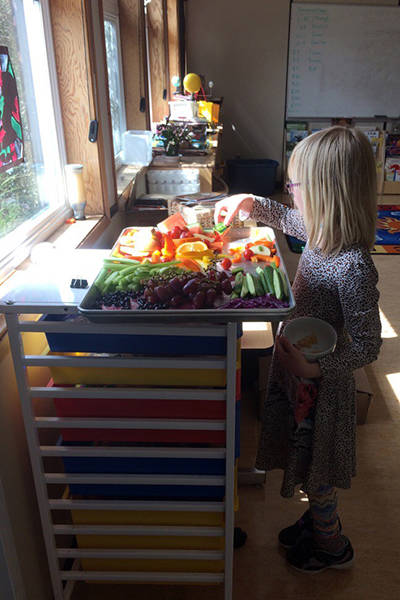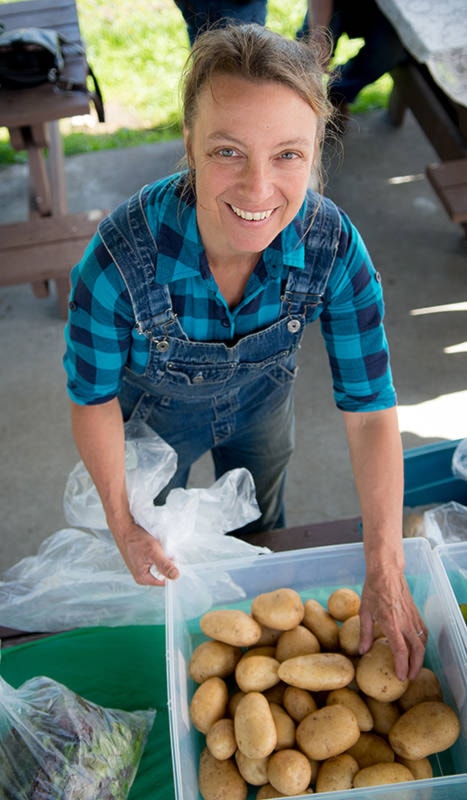By Trina Moyles
How are women working to harvest local foods, feed community, and promote food security on Haida Gwaii – one of the most remote island populations in Canada?
A few months ago, a hunger to answer this question led me on a road trip from northern Alberta and across the Hecate Strait to Graham Island, where I’ve been learning about women and food culture while enjoying the flavours of wild salmon, crab, chanterelles, venison, and local root vegetables.
My interest in writing about women and food culture has grown into a passion project. Recently, I wrote and published a book called Women Who Dig: Farming, Feminism, and the Fight to Feed the World.
The book is about my travels across three continents, from northern Canada to Sub-Saharan Africa to southern India, to document the importance of women’s work in growing food, nourishing communities, and stewarding the land. According to the United Nations, women account for 43 per cent of the global agriculture force.
Over the past several months, I’ve been privileged to meet and spend time with women in Haida Gwaii — mothers, community organizers, and elders — who are working to overcome barriers of food security by harvesting, processing, and sharing local foods with their communities.
“There’s so many women on Haida Gwaii who are involved with food, whether they’re farmers, gardeners, hunters, or gatherers,” says Shelly Crack, a community dietitian with Northern Health in Masset.
“Women are feeding their families, schools, and the hospitals. [Food] is a way of loving people.”
In light of International Women’s Day on March 8, I’m pleased to share several inspiring stories of women on Haida Gwaii whose efforts are collectively feeding the island.
| Dr. Dolly Garza, author of Common Edible Seaweeds in the Gulf of Alaska, leads a seaweed-identification workshop at Skonun Point. (File photo/Haida Gwaii Observer) |
Haida women reclaiming traditional food culture
“In the spring, after the salmonberry flowers have blossomed, you have two choices,” explains Marlene Liddle, a Haida woman of the Yahulanaas Clan (Raven) in Masset. “Harvest seaweed, or cedar bark.”
Liddle works as a professional artist, harvesting red and yellow cedar bark to weave into baskets, hats, and traditional clothing.
“For me, it’s a hard time of year,” she says. “But the cedar bark will wait, so I generally go out for the seaweed.”
From a young age, Liddle learned the seasonal rhythm of wild foods on Haida Gwaii. Her grandmother taught her how, when, and where to harvest seaweed, dig for clams, and grow potatoes. Spring was time for seaweed and gardening. By June, it was time for fishing.
“In mid-summer, you’re ready for berry picking – blueberries, huckleberries, salmonberries, elderberries, strawberries,” says Liddle. “In the old days, there was seagull egg harvesting.”
Come April, Liddle will take a boat out to harvest sgyuudang: long, thin, olive-green coloured seaweed. She will also look for chitons — black molluscs that can be found on the rocks.
Liddle’s grandmother taught her to cut open the chitons and mix them into the seaweed, before drying. The chitons add protein to the nutrient-rich seaweed.
“It’s one of the best foods for you,” says Liddle. “You could survive off of seaweed.”
Before contact with Europeans, the Haida were one of the few native groups on the coast to practice agriculture, cultivating a type of native tobacco called Nicotiana quadrivalis. After colonial contact in the late 1700s, Haida women grew potatoes, carrots, and other root vegetables. The month of April was called t’aawkanut, or gardening time.
“In the early 1960s, everyone had their own house garden. My grandmother grew potatoes, radishes, and carrots,” recalls Liddle. “We didn’t have food coming on the ferries, or grocery stores like today.”
Due to the legacy of Canada’s residential school system, many Haida were taken to schools on the mainland and never learned how, when, or where to harvest traditional foods. But Liddle says she’s happy to see a resurgence in Haida people fishing, gathering, and growing food.
When her granddaughter gets older, Liddle plans to teach her how to pull cedar bark, pick berries, gather seaweed – and k’yuudang, dig for clams.
“Food harvesting is who we are,” says Liddle. “That’s our tie to the land, to harvest, to provide for everybody in our families and clans.”
| Lynda Dixon started growing organic, islands-grown produce at Maude Island Farm in 1994. (Jason Shafto/Love Haida Gwaii) |
Women farmers growing a local food economy
Lynda Dixon first came to Haida Gwaii in 1987 to work as a registered nurse at the hospital in Queen Charlotte. One day, as Dixon was kayaking around Skidegate Inlet, on the south side of Maude Island, an idea began to take root in her mind.
“I fell in love with the land,” she recalls. She longed to quit her job as a diabetes nurse, and instead to grow fresh, organic vegetables for the island.
In 1994, Dixon and her partner, Laird Bateham, cleared three acres of land on Maude Island to start one of the first certified organic farm operations on Haida Gwaii.
Today, Maude Island Farm grows a wide array of vegetables and herbs, including beets, carrots, asparagus, summer squash, rainbow chard, garlic, peas, and salad greens. This year, she’s excited to experiment with growing commercial tomatoes.
Most of what she grows is sold directly to islanders. Dixon sells her produce every Saturday at the Farmers’ Market in Queen Charlotte. She also sells through a weekly CSA (community-supported agriculture) vegetable box program.
“Kids go crazy when they eat my carrots because they don’t taste like a grocery store carrot,” she says, laughing. “If you can get young children excited about good, fresh, local food, it’s totally rewarding.”
But farming on Haida Gwaii can be incredibly challenging.
Dixon credits the island’s remote location as being both “unique, and a pain.” One of the major challenges is selling all of her product to keep the farm economically viable.
Recently, she’s joined forces with other local food producers, many of them women, to form the Haida Gwaii Gourmet Collective. Together, they’re selling their products, including garlic, dried mushrooms and kelp, to southern markets in Vancouver.
Dixon’s main focus as a farmer, however, is to nourish the local population. She’s driven to find ways to build up the local food economy and make healthy food more accessible.
“It’s the advantage of living and working in the community that you’re feeding,” she says. “You see the excitement over fresh food – along with the health benefits.”
Over the past 24 years, Dixon has also noticed a growing trend of young women who come to Maude Island Farm to work as interns.
“I’m seeing this new generation of young women that want to get into agriculture,” she says. “They’re focused and hard working. They really want to farm.”
Islands women nourishing schools and hospitals
“Our goal is to bring local food connection into the schools,” says Shelly Crack, one of the key organizers behind the Local Food to Schools program, an initiative that provides hot, nutritious (and locally sourced) meals to nine elementary and high schools on the island.
The program sources local fish, seafood, seaweed, berries, venison, and vegetables from a wide network of community partners, many of them women. Local Food to Schools is guided by a new Haida Foods Committee that provides leadership around when, where, and how to harvest traditional food.
| Haida Gwaii kids learn to cook healthy, local foods through the Local Food to Schools program. (Local Foods to Schools/Submitted) |
“We organize different food harvesting and processing workshops in the schools,” said Crack. “The kids go on field trips to harvest berries, or dig clams. They learn how to make jam, fruit leather, how to filet fish, preserve, and store them.”
Crack credits the success of the islands-wide initiative to the cooperation of local community partners. “When we have learning circles, we bring everyone together. The work of local food to school is all island, all schools.”
Helen Davis is the head chef at the Old Massett Village Council (OMVC)’s culinary arts program. Every week, she and her team prepare 800 meals for students, including a monthly meal at the Northern Haida Gwaii Hospital. On Davis’s menu at the Masset Hospital this month: halibut curry with locally grown vegetables, and a berry dessert.
Crack commends the efforts of women like Davis, amongst many others, who are involved in the school and hospital food programs.
“Women here have a strong sense of knowledge and experience with food,” she says. “If we keep building this connection to food, the whole community becomes healthier.”
Trina Moyles is a Canadian-based freelance writer, and the author of Women Who Dig: Farming, Feminism, and the Fight to Feed the World (University of Regina Press). Read more at www.trinamoyles.com

